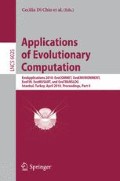Abstract
A relatively rare application of artificial intelligence at the nexus of art and music is dance. The impulse shared by all humans to express ourselves through dance represents a unique opportunity to artificially capture human creative expression. In particular, the spontaneity and relative ease of moving to the music without any overall plan suggests a natural connection between temporal patterns and motor control. To explore this potential, this paper presents a model called Dance Evolution, which allows the user to train virtual humans to dance to MIDI songs or raw audio, that is, the dancers can dance to any song heard on the radio, including the latest pop music. The dancers are controlled by artificial neural networks (ANNs) that “hear” MIDI sequences or raw audio processed through a discrete Fourier transform-based technique. ANNs learn to dance in new ways through an interactive evolutionary process driven by the user. The main result is that when motion is expressed as a function of sound the effect is a plausible approximation of the natural human tendency to move to music.
Access this chapter
Tax calculation will be finalised at checkout
Purchases are for personal use only
Preview
Unable to display preview. Download preview PDF.
References
Kurath, G.P.: Panorama of dance ethnology. Curr. Anthropol. 1(3), 233–254 (1960)
Hoover, A.K., Rosario, M.P., Stanley, K.O.: Scaffolding for interactively evolving novel drum tracks for existing songs. In: Giacobini, M., et al. (eds.) EvoWorkshops 2008. LNCS, vol. 4974, pp. 412–422. Springer, Heidelberg (2008)
Romero, J., Machado, P. (eds.): The Art of Artificial Evolution: A Handbook on Evolutionary Art and Music. Natural Computing Series. Springer, Heidelberg (2007)
Secretan, J., Beato, N., D’Ambrosio, D.B., Rodriguez, A., Campbell, A., Stanley, K.O.: Picbreeder: Evolving pictures collaboratively online. In: CHI 2008: Proc. of the 26th annual SIGCHI, pp. 1759–1768. ACM, New York (2008)
Sims, K.: Artificial evolution for computer graphics. In: Proc. of SIGGRAPH, pp. 319–328. ACM Press, New York (1991)
Yu, T., Johnson, P.: Tour jeté, pirouette: Dance choreographing by computers. In: Cantú-Paz, E., Foster, J.A., Deb, K., Davis, L., Roy, R., O’Reilly, U.-M., Beyer, H.-G., Kendall, G., Wilson, S.W., Harman, M., Wegener, J., Dasgupta, D., Potter, M.A., Schultz, A., Dowsland, K.A., Jonoska, N., Miller, J., Standish, R.K. (eds.) GECCO 2003. LNCS, vol. 2724, pp. 156–157. Springer, Heidelberg (2003)
Takagi, H.: Interactive evolutionary computation: Fusion of the capacities of ec optimization and human evaluation. In: Proc. of the IEEE, pp. 1275–1296 (2001)
Dawkins, R.: The Blind Watchmaker: Why the Evidence of Evolution Reveals a Universe Without Design. W. W. Norton (September 1986)
Sims, K.: Evolving virtual creatures. In: SIGGRAPH 1994: Comp. Graph, pp. 15–22. ACM, New York (1994)
Taylor, M.E., Whiteson, S., Stone, P.: Temporal difference and policy search methods for reinforcement learning: An empirical comparison. In: Proc. of the Twenty-Second Conference on AI, July 2007, pp. 1675–1678 (2007); Nectar Track
Stanley, K.O., Bryant, B.D., Miikkulainen, R.: Evolving neural network agents in the nero video game. In: Proc. of the IEEE 2005, CIG 2005 (2005)
Stanley, K.O., Miikkulainen, R.: Evolving neural networks through augmenting topologies. Evolutionary Computation 10, 99–127 (2002)
Scheirer, E.D.: Tempo and beat analysis of acoustic musical signals. Journal of Acoustical Society of America 103(1), 588–601 (1998)
Balogh, J., Dubbin, G., Do, M., Stanley, K.O.: Dance evolution. In: Proceedings of the Twenty Second AAAI AI Video Competition. AAAI Press, Menlo Park (2007)
Stanley, K.O., D’Ambrosio, D.B., Gauci, J.: A hypercube-based indirect encoding for evolving large-scale neural networks. Artificial Life 15 (2009)
Stanley, K.O., Miikkulainen, R.: A taxonomy for artificial embryogeny. Artif. Life 9(2), 93–130 (2003)
Author information
Authors and Affiliations
Editor information
Editors and Affiliations
Rights and permissions
Copyright information
© 2010 Springer-Verlag Berlin Heidelberg
About this paper
Cite this paper
Dubbin, G.A., Stanley, K.O. (2010). Learning to Dance through Interactive Evolution. In: Di Chio, C., et al. Applications of Evolutionary Computation. EvoApplications 2010. Lecture Notes in Computer Science, vol 6025. Springer, Berlin, Heidelberg. https://doi.org/10.1007/978-3-642-12242-2_34
Download citation
DOI: https://doi.org/10.1007/978-3-642-12242-2_34
Publisher Name: Springer, Berlin, Heidelberg
Print ISBN: 978-3-642-12241-5
Online ISBN: 978-3-642-12242-2
eBook Packages: Computer ScienceComputer Science (R0)

